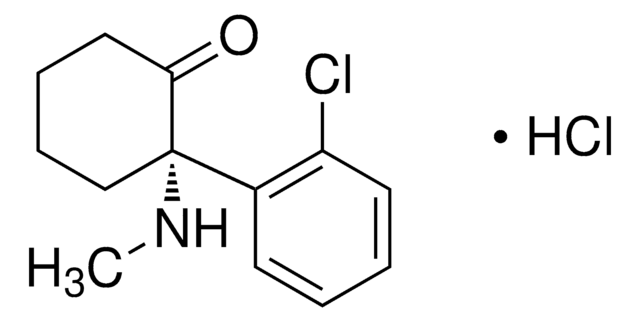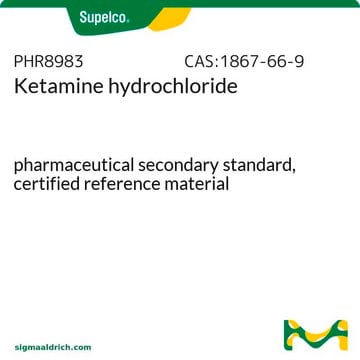K-002
Ketamine hydrochloride solution
1.0 mg/mL in methanol (as free base), ampule of 1 mL, certified reference material, Cerilliant®
About This Item
Recommended Products
grade
certified reference material
form
liquid
feature
Snap-N-Spike®/Snap-N-Shoot®
packaging
ampule of 1 mL
manufacturer/tradename
Cerilliant®
drug control
psicótropo (Spain)
concentration
1.0 mg/mL in methanol (as free base)
technique(s)
gas chromatography (GC): suitable
liquid chromatography (LC): suitable
application(s)
forensics and toxicology
format
single component solution
storage temp.
−20°C
InChI
1S/C13H16ClNO.ClH/c1-15-13(9-5-4-8-12(13)16)10-6-2-3-7-11(10)14;/h2-3,6-7,15H,4-5,8-9H2,1H3;1H
InChI key
VCMGMSHEPQENPE-UHFFFAOYSA-N
Gene Information
human ... GRIN1(2902) , GRIN2A(2903) , GRIN2B(2904) , GRIN2C(2905) , GRIN2D(2906) , GRIN3A(116443) , GRIN3B(116444)
General description
Ketamine is a phencyclidine type of anaesthetic drug that blocks the N-methyl-d-aspartate (NMDA) receptors present on neurons. It is also an abused drug owing to its euphoric and hallucinogenic effects. The drug is also abused at clubs, raves, or parties for its noted hallucinogenic and dissociative properties and is prescribed by some doctors as an off-label treatment for depression.
Application
- Development of a chiral liquid chromatography-tandem mass spectrometric (LC-MS/MS) method to quantify enantiomers of ketamine and norketamine in plasma, brain, and cerebrospinal fluid samples obtained from mouse
- Multi-residue and non-destructive analysis of ketamine, methamphetamine, heroin, and cocaine by a near-infrared spectroscopic (NIR) method in seized drug samples
- Combined detection and estimation of ketamine, free methamphetamine, pethidine, and tramadol in human urine samples using dispersive liquid-liquid microextraction (DLLME) and gas chromatography-mass spectrometry (GC-MS)
- Electrochemical determination of ketamine in human urine samples using a metal-organic framework/graphene nanocomposite (MOFs@G) modified screen-printed electrode (SPE) after the UV polymerization of molecularly imprinted membranes on its surface
- Simultaneous analysis of ketamine, GHB, norketamine, phenobarbital, thiopental, zolpidem, zopiclone, and phenytoin in human urine samples by a LC-MS/MS procedure following a four-step liquid-liquid extraction of the samples
Features and Benefits
- Fully characterized under ISO/IEC 17025 and ISO 17034 accreditation
- Accompanied with a comprehensive Certificate of Analysis (CoA) with data on stability, homogeneity, accuracy of concentration, uncertainty, and traceability
- Rigorously tested through real-time stability studies to ensure accuracy and shelf life
- Gravimetrically prepared using qualified precision balances to ensure minimal uncertainty
- Flame sealed under argon into ampoules for long-term shelf life
- Offered in a convenient, DEA-exempt format to improve laboratory efficiency
Legal Information
related product
Signal Word
Danger
Hazard Statements
Precautionary Statements
Hazard Classifications
Acute Tox. 3 Dermal - Acute Tox. 3 Inhalation - Acute Tox. 3 Oral - Flam. Liq. 2 - STOT SE 1
Target Organs
Eyes
Storage Class Code
3 - Flammable liquids
WGK
WGK 2
Flash Point(F)
49.5 °F - closed cup
Flash Point(C)
9.7 °C - closed cup
Certificates of Analysis (COA)
Search for Certificates of Analysis (COA) by entering the products Lot/Batch Number. Lot and Batch Numbers can be found on a product’s label following the words ‘Lot’ or ‘Batch’.
Already Own This Product?
Find documentation for the products that you have recently purchased in the Document Library.
Customers Also Viewed
Our team of scientists has experience in all areas of research including Life Science, Material Science, Chemical Synthesis, Chromatography, Analytical and many others.
Contact Technical Service













